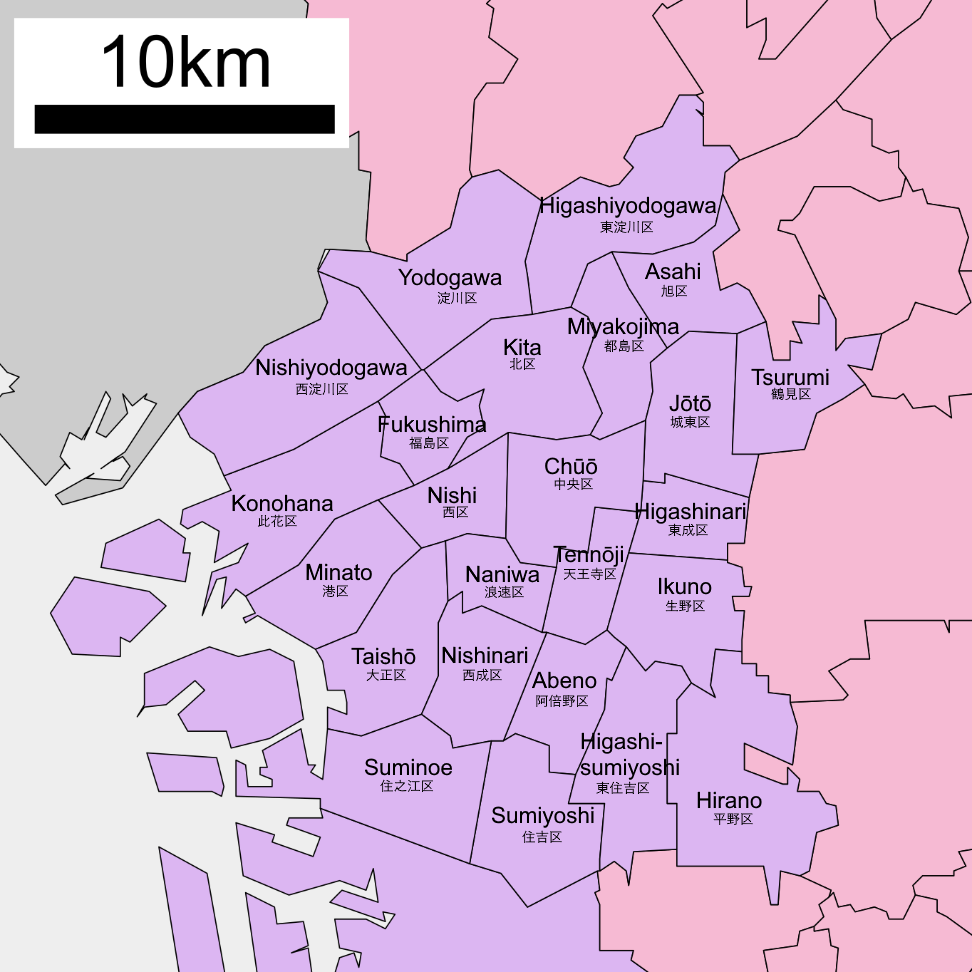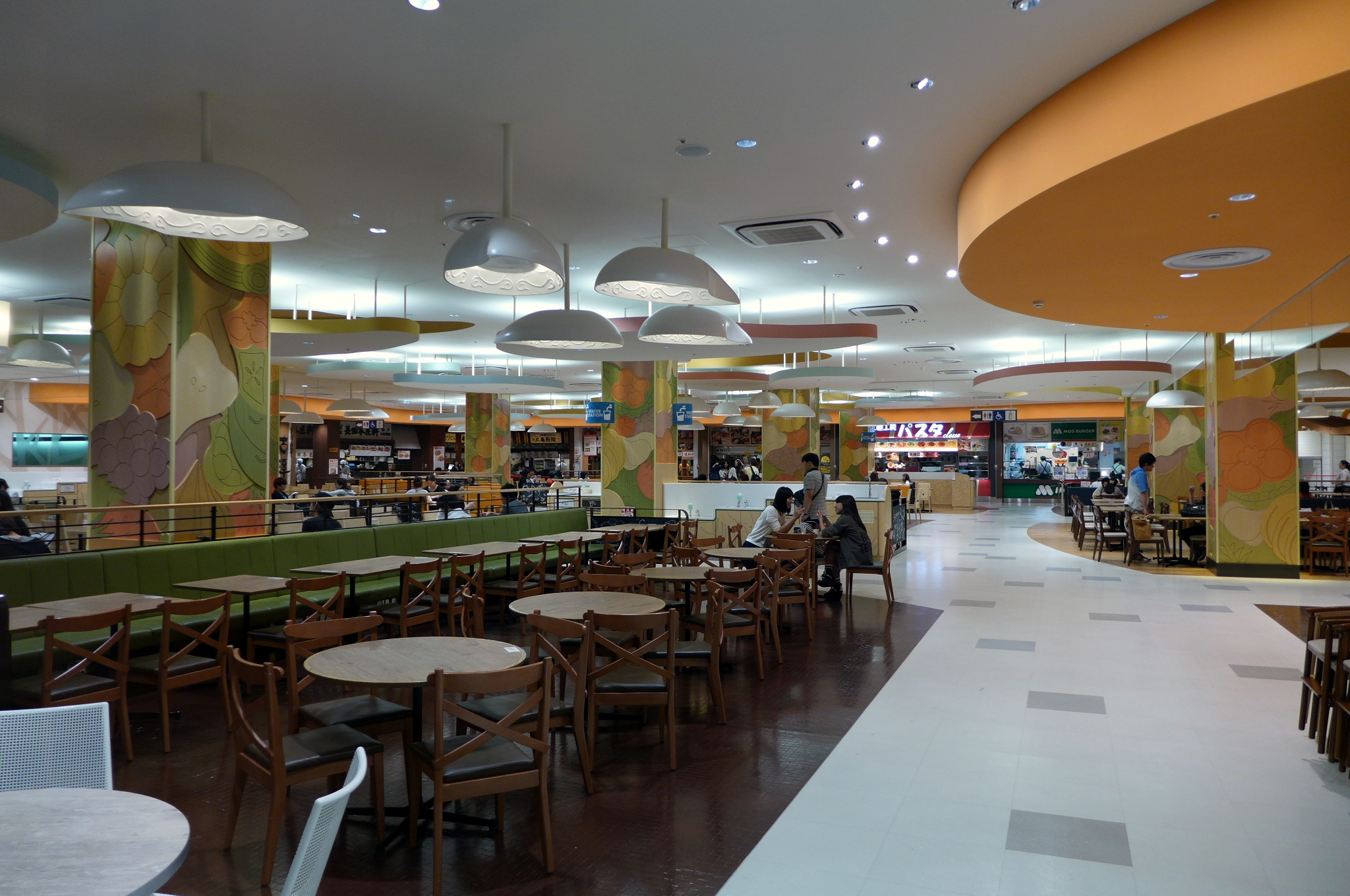|
┼īsaka Abenobashi Station
is a railway station on Kintetsu Minami Osaka Line in Abeno-ku, Osaka, Japan. The station is also called "Abenobashi Station" (ŃüéŃü╣Ńü«µ®ŗķ¦ģ). According to the research on November 13, 2012, 159,075 passengers got on and off trains at ┼īsaka Abenobashi Station. It was the largest number of passengers getting on and off trains at stations on the Kintetsu Lines. The west ticket gates of the station were shifted 35 m to the east on March 20, 2009, so that station facilities are entirely within the Kintetsu Abeno department store's "new" (east) building. The "old" (western) portion was demolished to make way for a new high-rise building. Connecting lines * Tennoji Station **West Japan Railway Company (JR West) *:*Osaka Loop Line *:*Hanwa Line *:*Yamatoji Line **Osaka Metro *:* Midosuji Line (M23) *:*Tanimachi Line (T27) * Tennoji-eki-mae Station **Hankai Tramway Uemachi Line Layout The station has six bay platforms serving five tracks on the first floor. ;Minami-Osaka ... [...More Info...] [...Related Items...] OR: [Wikipedia] [Google] [Baidu] |
Abeno-ku, Osaka
is one of 24 wards of Osaka, Japan. It is located in southern Osaka city and has a population of over 107,000. In the northern part of Abeno, Abenobashi, there is the Kintetsu Minami Osaka Line which terminates at Abenobashi Station, the Mid┼Źsuji Line and Tanimachi Line of the Osaka Municipal Subway at Tennoji Station, and the Hankai Tramway's Uemachi Line which terminates at Tennoji-eki-mae Station. The Abenobashi area of Abeno is a commercial area where department stores and movie theatres are located. Abeno is a home for Sharp Corporation ( Nagaike-cho). History When Osaka city increased its number of wards from 15 to 22 on April 1, 1943, Sumiyoshi ward was divided into three "new" wards, one of which was Abeno, the others being Higashi-Sumiyoshi ward and Sumiyoshi ward. There are varying theories as to the origin of the name "Abeno". One is that it was the name of a powerful family-clan in ancient Japan, another suggests it might come from one of Yamabe no Akahito's so ... [...More Info...] [...Related Items...] OR: [Wikipedia] [Google] [Baidu] |
Hankai Tramway
is a company which owns two tramway lines in the cities of Osaka and Sakai, Osaka, Japan. The parent company is Nankai Electric Railway Co., Ltd. Lines Current * Hankai Line (Ebisucho - Hamadera eki-mae) 14.1 km * Uemachi Line (Tennoji eki-mae - Sumiyoshikoen) 4.6 km The lines use standard gauge A standard-gauge railway is a railway with a track gauge of . The standard gauge is also called Stephenson gauge (after George Stephenson), International gauge, UIC gauge, uniform gauge, normal gauge and European gauge in Europe, and SGR in Ea ... tracks and are electrified at 600 Volts via catenary. Former lines when owned by Nankai Railway *Hirano Line (Imaike - Hirano) 5.9 km *Ohama Branch Line (Shukuin - Ohama-kaigan) 1.4 km Rolling stock Current *161 series *351 series *501 series *601 series *701 series *1001 series *1101 series File:Hankai_161_(49301503486).jpg, 161 series File:ķś¬ÕĀ║ķø╗µ░ŚĶ╗īķüōŃāó’╝ō’╝Ģ’╝æÕĮó’╝ō’╝Ģ’╝æÕÅĘ.jpg, 351 series File:Han ... [...More Info...] [...Related Items...] OR: [Wikipedia] [Google] [Baidu] |
Namba
is a district of Osaka, Japan. It is located in Ch┼½┼Ź and Naniwa wards. Namba is regarded as the center of so-called ''Minami'' ("South") area of Osaka. Its name is one of variations on the former name of Osaka, '' Naniwa''. Namba is best known as the city's main south-central railway terminus: JR, Kintetsu, Nankai, Hanshin, and three Osaka Metro subway lines have stations there. Some of the most famous images of Osaka, including the Glico Man and the Kani Doraku Crab, are located around the D┼Źtonbori canal in Namba. Namba is also known as an entertainment district, and hosts many of the city's most popular bars, restaurants, nightclubs, arcades, and pachinko parlors. The area is also known for shopping, with the Takashimaya department store (for older styles) and the sprawling underground Namba City shopping mall (for newer styles). Namba Parks is a new development consisting of a high office building, called "Parks Tower," and a 120-tenant shopping mall with ... [...More Info...] [...Related Items...] OR: [Wikipedia] [Google] [Baidu] |
Osaka Station
is a designated city in the Kansai region of Honshu in Japan. It is the capital of and most populous city in Osaka Prefecture, and the third most populous city in Japan, following Special wards of Tokyo and Yokohama. With a population of 2.7 million in the 2020 census, it is also the largest component of the Keihanshin Metropolitan Area, which is the second-largest metropolitan area in Japan and the 10th largest urban area in the world with more than 19 million inhabitants. Osaka was traditionally considered Japan's economic hub. By the Kofun period (300ŌĆō538) it had developed into an important regional port, and in the 7th and 8th centuries, it served briefly as the imperial capital. Osaka continued to flourish during the Edo period (1603ŌĆō1867) and became known as a center of Japanese culture. Following the Meiji Restoration, Osaka greatly expanded in size and underwent rapid industrialization. In 1889, Osaka was officially established as a municipality. The constructi ... [...More Info...] [...Related Items...] OR: [Wikipedia] [Google] [Baidu] |
Fuse Station
is an interchange passenger railway station located in the city of Higashi┼Źsaka, Osaka Prefecture, Japan, operated by the private railway operator Kintetsu Railway. Lines Fuse Station is served by the Osaka Line, and is located 4.1 rail kilometers from the starting point of the line at ┼īsaka Uehommachi Station. It is also the nominal terminus of the Nara Line and is 26.7 kilometers from the opposing terminus at Kintetsu Nara Station. Station layout The station has four levels; the first two levels are Kintetsu Department Store, the third level is for the Osaka Line, and the fourth level is for the Nara Line. There is an island platform serving 2 tracks between 2 passing tracks each on the third level and the fourth levels. ;3rd level ;4th level Adjacent stations Bus ;North :Osaka Municipal Transportation Bureau (Fuse-ekimae) :*Route 12 for :*Route 86 for :Osaka Bus Co., Ltd. (Higashi-Osaka Fuse) :*for Kyoto :*for Nagoya :*for Tokyo ;South :Kintets ... [...More Info...] [...Related Items...] OR: [Wikipedia] [Google] [Baidu] |
Osaka City Bus
is a designated city in the Kansai region of Honshu in Japan. It is the capital of and most populous city in Osaka Prefecture, and the third most populous city in Japan, following Special wards of Tokyo and Yokohama. With a population of 2.7 million in the 2020 census, it is also the largest component of the Keihanshin Metropolitan Area, which is the second-largest metropolitan area in Japan and the 10th largest urban area in the world with more than 19 million inhabitants. Osaka was traditionally considered Japan's economic hub. By the Kofun period (300ŌĆō538) it had developed into an important regional port, and in the 7th and 8th centuries, it served briefly as the imperial capital. Osaka continued to flourish during the Edo period (1603ŌĆō1867) and became known as a center of Japanese culture. Following the Meiji Restoration, Osaka greatly expanded in size and underwent rapid industrialization. In 1889, Osaka was officially established as a municipality. The constru ... [...More Info...] [...Related Items...] OR: [Wikipedia] [Google] [Baidu] |
Shitenn┼Ź-ji
Shitenn┼Ź-ji ( ja, ÕøøÕż®ńÄŗÕ»║, ''Temple of the Four Heavenly Kings'') is a Buddhist temple in ┼īsaka, Japan. It is also known as Arahaka-ji, Nanba-ji, or Mitsu-ji. The temple is sometimes regarded as the first Buddhist and oldest officially-administered temple in Japan, although the temple complex and buildings have been rebuilt over the centuries, with the last reconstruction taking place in 1963. It is the head temple of the Wa Sect of Buddhism. History Prince Sh┼Źtoku was known for his profound Buddhist faith when Buddhism was not widespread in Japan during the 6th century. In order to popularize Buddhism, Prince Sh┼Źtoku lead a massive national project to promote Buddhism and he commissioned the construction of Shitenn┼Ź-ji. Prince Sh┼Źtoku invited three Korean carpenters from Baekje. They brought knowledge and led the construction of Shitenn┼Ź-ji. The commission of Shitenn┼Ź-ji was part of a massive national project led by Prince Sh┼Źtoku. The temple buildings themsel ... [...More Info...] [...Related Items...] OR: [Wikipedia] [Google] [Baidu] |
Osaka Municipal Museum Of Art
The is a museum located in Tenn┼Źji Park, Tenn┼Źji-ku, Osaka, Japan. The museum focuses on Japanese and east Asian art. Collection File:Katsushika Hokusai - Shell Gathering - Google Art Project.jpg, Hokusai, Shell Gathering, 19th century File:Mi Fu - Calligraphy in Grass Script - Google Art Project.jpg, Mi Fu, Calligraphy in Grass Script, late 11th century File:Gong Suran - Ming Consort Leaving the Country - Google Art Project.jpg, Gong Suran, 12th-13th century File:õ║öµś¤õ║īÕŹüÕģ½Õ«┐ńź×ÕĮóÕøŠ.jpg, The Five Stars and 28 Heavenly Abodes, Zhang Sengyou, Liang dynasty (5-6th century) Access *Osaka Municipal Subway ** Midosuji Line, Tanimachi Line: Tennoji Station *JR West **Yamatoji Line, Osaka Loop Line, Hanwa Line: Tennoji Station * Kintetsu **Minami Osaka Line: Osaka Abenobashi Station Notes External links Official Web site [...More Info...] [...Related Items...] OR: [Wikipedia] [Google] [Baidu] |
Abeno Cues Town
is the name of in Abeno-ku, Osaka, Japan. Overview Abeno Cues Town consists of and . Via Abeno Walk is the area for the local tenants, and Q's Mall is the area the specific architect, Tokyu Land Corporation, manages. The area opened on April 26, 2011. This shopping area is connected to Tennoji Station operated by Osaka Metro by the underground passage. The area is connected to the pedestrian bridge (pre-opened on February 1, 2012, and completed on April 24, 2013) via the Abeno A1 Area Urban Redevelopment Project A1-2 Building (Abeno nini) opened on February 1, 2012 along with the elevated walkway between Cues Town and Abeno nini. The other passage was opened on March 15, 2014 to connect to Abeno Station on the Osaka Metro Tanimachi Line. Access *Osaka Metro: Tennoji Station ( Midosuji Line, Tanimachi Line), Abeno Station (Tanimachi Line) *JR West: Tennoji Station (Yamatoji Line, Osaka Loop Line, Hanwa Line) * Kintetsu Minami Osaka Line: Osaka Abenobashi Station *Hankai Ue ... [...More Info...] [...Related Items...] OR: [Wikipedia] [Google] [Baidu] |
Kintetsu Department Store
is a department store chain in the Kansai region, Japan. It is headquartered in Abenosuji Itchome, Abeno-ku, Osaka, Japan. History *January, 1920: was opened in front of Kyoto Station. *February, 1920: was founded. *1926: opened its own restaurant at Daiki Building in Uehommachi, Osaka. *1930: Kyoto Bussankan General Partnership opened branch store in Yanagase, Gifu. *September, 1931: Kyoto Bussankan General Partnership was renamed . *September 29, 1934: Marubutsu General Partnership was reorganised as . *1934: founded . *September, 1936: was opened in Uehommachi, Osaka. *November, 1937: Daitetsu Department Store was opened in Abeno, Osaka. *March, 1941: Daiki consolidated Sangu Kyuko Railway Company and was renamed , thus, Daiki Department Store was renamed . *April 1, 1944: Kankyu consolidated Daitetsu Department Store Company, thus, Kankyu Department Store was reestablished as and as . *June 1, 1944: Kankyu and Nankai Railway were consolidated to form . Kankyu Departme ... [...More Info...] [...Related Items...] OR: [Wikipedia] [Google] [Baidu] |




